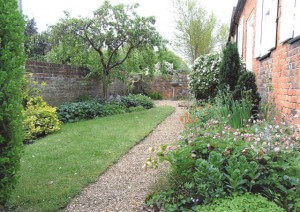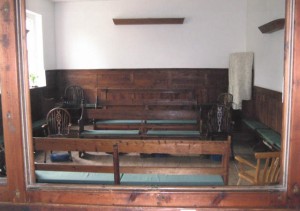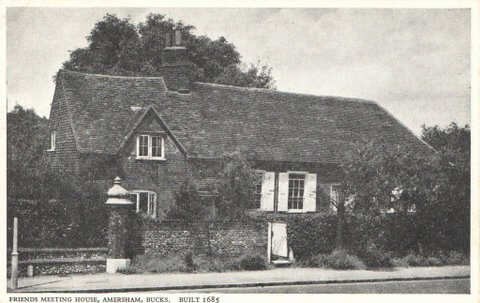

The timber-framed house which Joseph Winch built in 1624 was registered as a Quaker meeting place in 1689, the top end of the garden being used as burial ground. In the same year one of the main rooms was enlarged by one bay as the meeting room, and a wing was built out at the back of the dwelling a little later. The building was wholly refurbished in about 1780, when a brick extension was added for the women’s meeting, connected to the old by shutters in the traditional way. The older building was re-faced in brick, and the fittings in the old meeting room renewed.
The premises were not used by the Quakers from 1850 to 1916 and an attempt is being made to discover what use the Meeting House had been put to during those years, though it remained in Quaker ownership throughout. There are rumours of its being used as an art studio and for teaching purposes. (If you have any information, please contact us.) Latterly, presumably whilst the Old Town Methodist Church in the High Street was under construction, the local Wesleyan Methodists held services on the premises. Certainly one of the prime movers in achieving the re-opening of the Meeting House in 1917 was George Bolam, who used part of the premises as his woodworking workshop before moving to 16 Church Street. (His work can be sampled in several local churches: St Peter & St Paul, Great Missenden, and Stoke Poges for instance. He was Warden/Caretaker at the Meeting House until 1972.)
In 1926 the wider, overseeing Quaker meeting (known in those times as a Monthly Meeting) was constituted as a separate entity from the Leighton & Luton Monthly Meeting of which it had formerly been a part, the ‘split’ being made roughly along the course of the Euston railway line. It became Jordans Monthly Meeting. This was the body which, in 1927, confirmed Amersham’s local Quaker meeting as a full newly- constituted local meeting of the Religious Society of Friends, this being termed at that time a ‘Preparative Meeting’.
in 1957 a classroom and kitchen were added at the back and other improvements were made to meeting house and cottage, but since these in no way met the 21st-century needs either of the local Quaker community or of other bodies within the locality which use the premises today, in 2014 these additions were removed and a new, larger, extension added. Extensive repairs to the original roof, re-using as far as possible the original tiles, were carried out in 2016.


Click for more information about the Quakers in Amersham, the Quakers in the Chilterns, Isaac Penington or Thomas Ellwood.
This description of 1665 funeral of Edward Perot described by Thomas Ellwood tells of the persecution of the Quakers:
“When as the body was being borne on Friends shoulders along the street in order to be carried to the burying ground, which was at the town’s end, being part of an orchard belonging to the deceased …. Ambrose Benett [of Bulstrode] a barrister at law and Justice of the Peace …. rushed out of his inn with his constables and a rabble of rude fellows and having his drawn sword in his hand struck one of the foremost bearers with it, commanding them to set down the coffin. Enraged by their delay, Benett set his hand on the coffin and threw it to the ground in the open street and in the cartway, so that all the travellers that passed by (whether horsemen, coaches, carts or wagons) were fain to break out of the way to go by it, that they might not drive over it. The body was later buried in an unconsecrated part of the churchyard. The Friends were taken before Benett and another J.P. at the Griffin Hotel, ten of them being committed to the Gaol at Aylesbury.”
Click on any of the photographs below to enlarge it and to see the description. Then click on forward or back arrows at the foot of each photograph. To close the pictures, just click on one.





